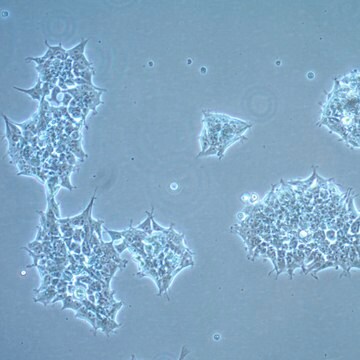293 Cell Line human
NOTE: Both the cell line and DNA from the cell line may be available for this product. Please choose -1VL or VIAL for cells, or -DNA-5UG for DNA, 85120602, human kidney (embryonic), Epithelial
Sinónimos:
HEK-293 Cells, HEK293 Cells, Human Embryonic Kidney 293 Cells
About This Item
Productos recomendados
biological source
human kidney (embryonic)
packaging
tube of 5 μg 85120602-DNA-5UG
pkg of vial of cells 85120602-1VL
growth mode
Adherent
karyotype
2n 46, hypotriploid, modal no. 64
morphology
Epithelial
products
Not specified
receptors
Not specified
technique(s)
cell culture | mammalian: suitable
shipped in
dry ice
storage temp.
−196°C
Cell Line Origin
Cell Line Description
Application
- to study the effects of the Bt insecticidal toxins Cry1Ab and Cry1Ac alone, or with a glyphosate-based herbicide.
- for toxicological studies of ethoxylated adjuvants of glyphosate-based herbicides.
- for stable expression of either type 1 or type 2 11-βHSD (11 β-hydroxysteroid dehydrogenase) after transfection with 11-βHSD cDNA.
- as a host to transfect TLR4 cDNA (HEK-TLR4) to express TLR4 mRNA and protein and induce IL-8 (interleukin-8) promoter activity in response to NE (neutrophil elastase).
DNA Profile
CSF1PO: 11,12
D13S317: 12,14
D16S539: 9,13
D5S818: 8,9
D7S820: 11,12
THO1: 7,9.3
TPOX: 11
vWA: 16,19
Culture Medium
Subculture Routine
Other Notes
Elija entre una de las versiones más recientes:
Certificados de análisis (COA)
It looks like we've run into a problem, but you can still download Certificates of Analysis from our Documentos section.
Si necesita más asistencia, póngase en contacto con Atención al cliente
¿Ya tiene este producto?
Encuentre la documentación para los productos que ha comprado recientemente en la Biblioteca de documentos.
Artículos
Eukaryotic cell lines aid in complex post-translational modifications and folding of recombinant proteins. Find suitable recombinant protein production cell lines at sigmaaldrich.com
DNA, RNA, cDNA derived from ECACC mammalian cell lines allow screening for genes or expression patterns to identify lines most suitable for specific research.
Nuestro equipo de científicos tiene experiencia en todas las áreas de investigación: Ciencias de la vida, Ciencia de los materiales, Síntesis química, Cromatografía, Analítica y muchas otras.
Póngase en contacto con el Servicio técnico








